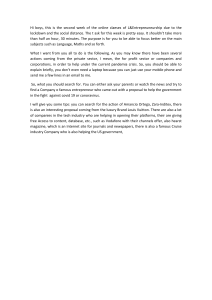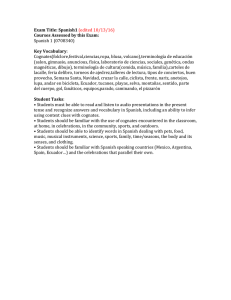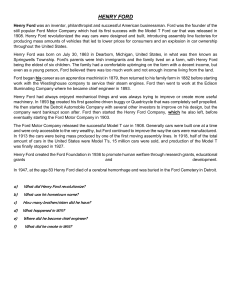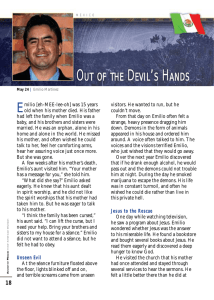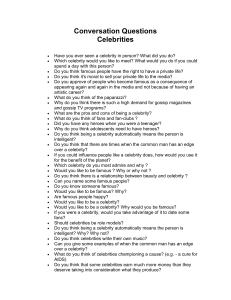FAMOUS PEOPLE of the 19th CENTURY
Anuncio
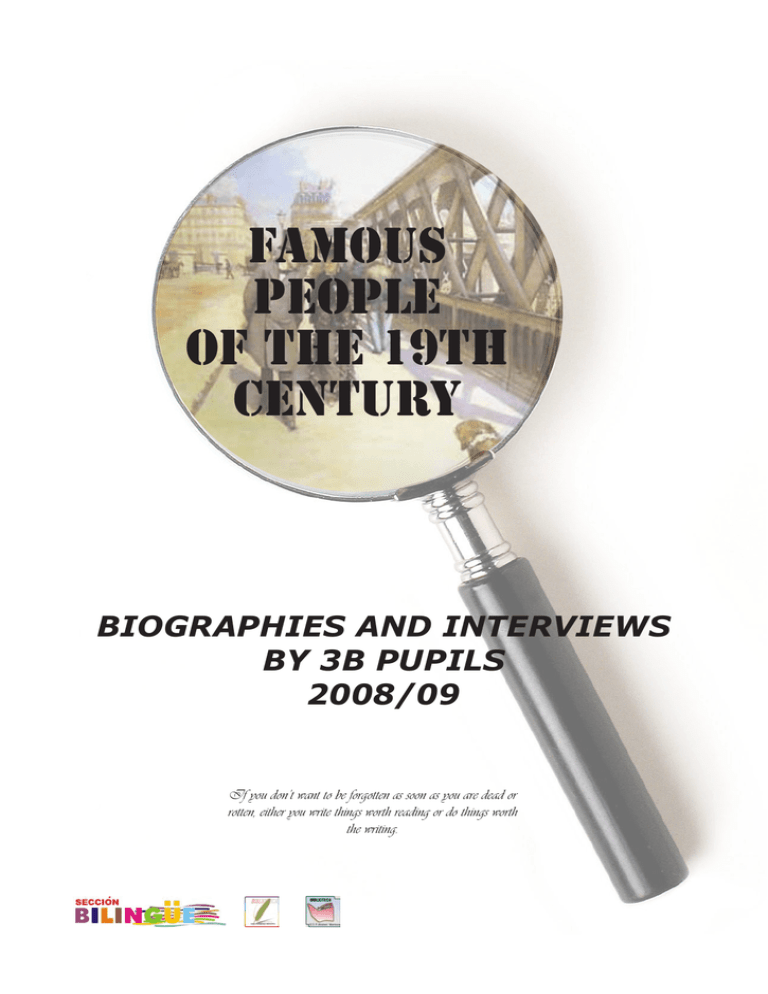
FAMOUS PEOPLE of the 19th CENTURY BIOGRAPHIES AND INTERVIEWS BY 3B PUPILS 2008/09 If you don’t want to be forgotten as soon as you are dead or rotten, either you write things worth reading or do things worth the writing. H ere is a collection of biographies and intreviews by 3B students. Famous men and women of the 19th century were interviewed after a process of research; this process started in the library and continued on Internet. Students themselves played the role of famous scientists, writers, inventors, musicians and politicians such as Edgar Allan Poe Thomas Edison, the Brönte Sisters, Jane Austen, Mark Twain, Robert Koch etc. Abraham Lincoln Cristian Sánchez interviewed by Jose Ant. López Robert Koch Mario Carrión interviewed by Antonio Rico Robert L. Stevenson Alberto Almirante interviewed by Almudena Hernández Thomas Alva Edison Francisco Gutierrez interviewed by Silvia Marín Edgar Allan Poe Carlos García interviewed by Ramón Gómez Mark Twain Pilar Martínez interviewed by Noelia Corral The Brönte Sisters Aida Centeno y Alba Jiménez interviewed by Jose Ant. López Henry James Maria Maestra interviewed by Angela Menéndez Chopin Estefanía Yeste interviewed by Alicia Henry Ford Francisco Polaino interviewed by Juan Pablo Martínez Henry James Henry James interviewed by Marjin Janssens Jane Austen Irene Sánchez interviewed by Aída Centeno THOMAS ALVA EDISON By Francisco Gutierrez Biography: He was born in a small town of Ohio (E.E.U.U.) called Milan, on February 11th 1.847. He grew up in Milan, but when he was seven years old, his family and him moved to Port Huron, in Michigan. In 1861, when he was 14 years old he started to work selling newspapers and when he was 16 years old, he left his town because it was very small to him. The next years he worked in a lot of towns and cities and patented his first invention (1968) until he achieved a very good work in New York (1869). He was one of the best inventors in the world. He is famous because he invented more of one thousand inventions but the most important inventions were The Phonograph (1877), The Light Bulb (1879), The Edison Effect (1883) and The Dictating Machine (1907). The Light Bulb made Edison become famous. His over one thousand inventions changed people’s habits. When he was 84 years old, he died in West Orange, New Jersey, on October 18th 1931. Personal background: • He was born in Milan, Ohio, United Sstates, on February 11th 1847. • He didn’t study any thing; he only read scientific and electric books. • He was smaller than his three brothers. His mother was called Nancy Elliot and his father was called Samuel Edison. • When he was young, he lived in Milan and in Port Huron. • When he was adult he lived in a lot of different cities and towns such as New York. Personality: • He was friendly, intelligent, competitive, talented, energetic, adventurous and funny. Famous for: • He is famous because he invented more of one thousand inventions, but everybody knows him because he invented The Light Bulb. Biggest obstacle: • His biggest obstacle was that he was partially deaf. Famous quotation: Genius is 1 percent inspiration and 99 percent perspiration Important inventions: •The Phonograph, in 1877. •The Light Bulb, in 1879. •The Edison Effect, in 1883. •The Kinetoscope Parlor, in 1894. •The Dictating Machine, in 1907. Curiosities: •He only went to the school three months because he was partially deaf and he didn’t pay attention in class. Bibliography: Title: Nueva Enciclopedia Larousse. Publication date: April, 1984, in Barcelona. Publisher: Editorial Planeta. Pages: 3170. by Francisco Polaino One of the most famous inventions is the car. It was invented in the XIX century but the first car was the steam machine. The making of the car took a long time but with the invention of the assembly line things changed because this new system saved time. The inventor of this was Henry Ford. Henry Ford was born on 30th of July in 1863, in the city Dearborn on a farm in the state of Michigan (United Stades). His parents were William Ford and Mary Liteget. His parents were very poor. When he was a student, he started repairing tractors. In 1873 the young Henry saw an auto propoesate machine which was used in agricultural activities. His parents gave him a clock and he repaired the clock. In 1878 he became a train driver in James F.Flawer & Brosy after that he worked in Detroit Dry Dock CO. In 1882 he went to Dearborn to work on a farm where he learnt to drive a portable steam machine. It was called Wastinghouse. He worked for Edison Illuminating Company. He had one son and called him Edsel. In 1891 he was one of the most important engineers. Then Henry used half of his time to make a car. He worked in a small garage. He invented one car with two cilindres and four times, refrigerated with water and without speed. In 1896 he introduced the construction in series and this allowed him to earn more money. The car cost 200 dollars. In 1903 created his own factory: Ford Motor Company. The best model was Ford T. The company finished making this car in 1927. In 1908 this first model was called FORTINGO. He sold 10.000.000 cars. This car sold better than other models such as V-8. He also wrote books. “My industrial philosophy” was published in 1929, he wrote other books with a collaborator, Samuel Crouther . “ My life and work ” was published in 1922 and “ Today and tomorrow ” in 1926. He patented 161 ideas. After that in 1927 the company made Ford A , B and T. All these models were very luxurious and faster than the previous model. Famous Quotation Coming together is a beginning, staying together is progress, and working together is success Emilio Castelar y Ripoll “A life in defence of the liberty” Author: Ramón Gómez Laguna Publication date: 22nd December 2008 Publisher: Alianza Editorial Biography Emilio Castelar y Ripoll was an important politician and a very good orator. He was the president of the 1st Spanish Republic. As an orator, he made some famous speeches such as: “Alcira’s speech”, “Spanish Cortes’ speech” (in a session of the Parliament where the Republic was proclaimed), and a lot more. He was also a writer. He was born in Cádiz, on September 7th 1832. Emilio’s father ran away to Gibratar due to King Fernando VII. After losing his father, he started to live in Elda (Alicante) with his mother’s family. Afterwards, he began to study Law and Philosophy at Madrid University. There, he met future rival politicians, such as Cánovas. When he finished University, to defend his ideals, he started to write for different newspapers, such as El Tribuno del Pueblo, La Soberanía Nacional, until he founded his own newspaper: La Democracia. But, before it he had written his first speech. It was in Madrid, in a meeting of the Democratic Party, he was only twenty two years old. In this speech, the people, the press considered him as an exceptional orator and a defender of the liberty and the democracy. He defended a democratic and liberal republicanism. In 1865, he wrote a famous article called “El rasgo”; in that article, he criticized Queen Isabel II. As a result, he was dismissed of his chair and from this moment, he suffered a lot of disturbances caused by students and professors. And all this was repressed with intensity and violence in the so called “Noche de San Daniel”. Emilio Castelar ran away to France, however he returned two years later to participate in a revolution called “La Gloriosa” that dethroned Isabel II. But there was no democracy. Spain tried to achieve the democracy with a new King, Amadeo I. But Amadeo I abdicated three years later. That same day, the Spanish Cortes held a meeting to decide the future of Spain: Republic or Monarchy? Amadeo I had abdicated, because of the difficult situation of Spain. When the Spanish Cortes session started, the majority of the members were monarchic, but Emilio Castelar delivered a famous speech. He changed the opinion of the Parliament. There is one sentence which summarizes the speech: “Señores, con Fernando VII, murió la Monarquía tradicional, con la fuga de Isabel II, la Monarquía parlamentaria; con la renuncia de Amadeo I, la Monarquía democrática; nadie ha acabado con ellas, han muerto por sí mismas; nadie trae la República, la traen todas las circunstancias, la trae una conjura de la sociedad, de la naturaleza y de la historia. Señores, saludémosla como el sol que se levanta por su propia fuerza en el cielo de nuestra patria”. Translation: “Gentlemen, with Fernando VII, the traditional Monarchy died, with the escape of Isabel II, the parliamentary Monarchy died, with the abdication of Amadeo I, the democratic Monarchy, nobody has finished with them, they died by themselves, nobody brings the Republic, all the things bring it , a plot of the society , of the nature and of the history brings it. Gentlemen we salute her, like the sun which rises because of its own intensity in the sky of our country”. And, then the Republic was proclaimed by 258 favorable votes and only 32 against. During the first republic government, he was the “state secretary”, and one of his laws was the eradication of the slavery in Puerto Rico, a Spanish colony. The presidency of the executive power (the head of the State and Government was the same) was passing hand to hand, until the Spanish Cortes appointed him “President”. To save the Republic, he passed new laws, but the situation of Spain was very difficult. He resigned on the 3rd of January, 1874. Afterwards, the Monarchy returned, he ran away to Paris, but he came back and he worked for the Spanish Royal Academy, and also in the Royal Academy of History. riod. Of course, Emilio Castelar returned to the Spanish “Cortes” during the Restoration pe- When two important laws were passed (universal vote and the law concerning the jury ), he retired from politics. He died in San Pedro del Pinatar, Murcia, on May 25th 1899. Bibliography - Larousse encyclopedia. - Sopena encyclopedia. - Historia de España. 2º Bachillerato. Editorial Algaida. - http://es.wikipedia.org/wiki/Emilio_ Castelar HENRY JAMES by Maria Hernández He was born in New York in 1843, in a wealthy family in New England. He wasn’t two years old, when his parents took him to Europe for the first time. Since 1855 to 1860 he travelled uninterruptly round Europe. In 1862 Henry joined in the Law’s University, at Harvard’s University. He received an education in schools of New York, London, Paris, Ginebra and his travels round Europe. In 1865 he started to produce some American magazines, publishing his first stories and articles. In 1875 he settled in Paris and he stayed there for one year, taking part in the intense cultural life of the French capital together with Flaubert and Turguénev. In 1882 after his parents´ death he decided to settle in London. In 1915 as consequence of the world war Henry became a British citizen, not far from his death, in 1916. Famous Quotation I've always been interested in people, but I've never liked them. TO BE CONTINUED . . .
